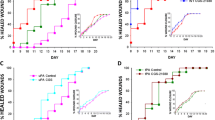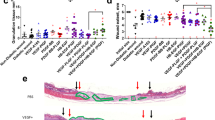Abstract
Animal studies of the topical application of adenosine A 2A receptor agonists show that it promotes wound closure. To further confirm the efficacy of adenosine A 2A receptor agonists as promoters of wound healing, we compared the effect of MRE0094, a novel selective adenosine A 2A receptor agonist, to CGS-21680, a reference selective adenosine A 2A receptor agonist, as well as to recombinant human platelet–derived growth factor (0.01% Becaplermin gel), an agent currently used to promote healing of diabetic ulcers, on wound closure in healthy BALB/C mice. Wounds (∼12 mm diameter) were created on the dorsum of mice (two per mouse) and then treated daily with vehicle, 0.01% Becaplermin gel, or different doses of the adenosine A 2A receptor agonists. The wound margins were traced onto plastic sheets, and the wound areas were digitized, quantitated, and compared. We found that application of MRE0094 (1 μg/wound and 10 μg/wound) and CGS-21680 (1 μg/wound and 5 μg/wound) achieved 50% wound closure significantly more rapidly than control application (day 1.9, 1.9, 3.5, 3.2, respectively, versus control day 4, p < 0.05 ANOVA). Surprisingly, neither higher nor lower concentrations of CGS-21680 affected the rate of wound closure, as compared to control. In contrast, Becaplermin gel did not increase the rate at which wounds closed (50% closure by day 7.2, p = NS versus control). These data confirm our prior observations that adenosine A 2A receptor agonists promote wound closure, and they suggest that these agents may be as effective if not more effective than Becaplermin gel for the treatment of poorly healing wounds.
Similar content being viewed by others
REFERENCES
Clark, R. A. 1993. Biology of dermal wound repair. Dermatol.Clin. 11:647–666.
Collis, M. G. and S. M. Hourani. 1993. Adenosine receptor subtypes.Trends Pharmacol. Sci. 14:360–366.
Cronstein, B. N. and C. M. Montesinos. 2001. Role of P1 receptors in inflammation. In Handbook of experimental pharmacology, purinergic and pyrimidinergic signalling II cardiovascular, respiratory, immune, metabolic and gastrointestinal tract function, pp. 303–321.
Dignass, A. U., A. Becker, S. Spiegler, and H. Goebell. 1998. Adenine nucleotides modulate epithelial wound healing in vitro. Eur.J. Clin. Invest. 28:554–561.
Embil, J. M., K. Papp, G. Sibbald, J. Tousignant, J. M. Smiell, B. Wong, and C. Y. Lau. 2000. Recombinant human platelet-derived growth factor-BB (becaplermin) for healing chronic lower extremity diabetic ulcers: An open-label clinical evaluation of efficacy.Wound Repair Regen. 8:162–168.
Ethier, M. F., V. Chander, and J. G. Dobson, Jr. 1993. Adenosine stimulates proliferation of human endothelial cells in culture. Am.J. Physiol. 265:H131–H138.
Graham, A. 1998. The use of growth factors in clinical practice.J. Wound Care 7:536–540.
Heldin, C. H. and B. Westermark. 1999. Mechanism of action and in vivo role of platelet-derived growth factor. Physiol. Rev. 79:1283–1316.
Hunt, T. K., H. Hopf, and Z. Hussain. 2000. Physiology of wound healing. Adv. Skin Wound Care 13:6–11.
Kartha, S. and F. G. Toback. 1992. Adenine nucleotides stimulate migration in wounded cultures of kidney epithelial cells. J. Clin.Invest. 90:288–292.
Kirsner, R. S. and W. H. Eaglstein. 1993. The wound healing process.Dermatol. Clin. 11:629–640.
Klotz, K. N. 2000. Adenosine receptors and their ligands. Naunyn Schmiedebergs Arch. Pharmacol. 362:382–391.
Koveker, G. B. (2000). Growth factors in clinical practice. Int. J.Clin. Pract. 54(9):590–593.
LeGrand, E. K. 1998. Preclinical promise of becaplermin (rhPDGF-BB) in wound healing. Am. J. Surg. 176:48S–54S.
Linden, J. 2001. Molecular approach to adenosine receptors: Receptor-mediated mechanisms of tissue protection. Annu. Rev.Pharmacol. Toxicol. 41:775–787.
Lutty, G. A., M. K. Mathews, C. Merges, and D. S. McLeod. 1998.Adenosine stimulates canine retinal microvascular endothelial cell migration and tube formation. Curr. Eye Res. 17:594–607.
Meininger, C. J., M. E. Schelling, and H. J. Granger. 1988. Adenosine and hypoxia stimulate proliferation and migration of endothelial cells. Am. J. Physiol. 255:H554–H562.
Meyer-Ingold, W. and W. Eichner. 1995. Platelet-derived growth factor. Cell Biol. Int. 19:389–398.
Montesinos, M. C., P. Gadangi, M. Longaker, J. Sung, J. Levine, D. Nilsen, J. Reibman, M. Li, C. K. Jiang, R. Hirschhorn, P. A. Recht, E. Ostad, R. I. Levin, and B. N. Cronstein. 1997. Wound healing is accelerated by agonists of adenosine A2 (G alpha slinked) receptors. J. Exp. Med. 186:1615–1620.
Moore, K. 1999. Cell biology of chronic wounds: The role of inflammation. J. Wound Care 8:345–348.
Pierce, G. F., J. E. Tarpley, R. M. Allman, P. S. Goode, C. M. Serdar, B. Morris, T. A. Mustoe, and J. Vande Berg. 1994. Tissue repair processes in healing chronic pressure ulcers treated with recombinant platelet-derived growth factor BB. Am. J. Pathol. 145:1399–1410.
Poulsen, S. A. and R. J. Quinn. 1998. Adenosine receptors: New opportunities for future drugs. Bioorg. Med. Chem. 6:619–641.
Robson, M. C., T. A. Mustoe, and T. K. Hunt. 1998. The future of recombinant growth factors in wound healing. Am. J. Surg. 176:80S–82S.
Sexl, V., G. Mancusi, S. Baumgartner-Parzer, W. Schutz, and M. Freissmuth. 1995. Stimulation of human umbilical vein endothelial cell proliferation by A2-adenosine and beta 2-adrenoceptors. Br. J.Pharmacol. 114:1577–1586.
Stadelmann, W. K., A. G. Digenis, and G. R. Tobin. 1998. Physiology and healing dynamics of chronic cutaneous wounds. Am. J.Surg. 176:26S–38S.
Steenfos, H. H. (1994). Growth factors and wound healing. Scand.J. Plast. Reconstr. Surg. Hand. 28(2):95–105.
Sun, L. L., L. L. Xu, T. B. Nielsen, P. Rhee, and D. Burris. 1999.Cyclopentyladenosine improves cell proliferation, wound healing, and hair growth. J. Surg. Res. 87:14–24.
Taomoto, M., D. S. McLeod, C. Merges, and G. A. Lutty. 2000.Localization of adenosine A2a receptor in retinal development and oxygen-induced retinopathy. Invest. Ophthalmol. Vis. Sci. 41:230–243.
Ueeda, M., R. D. Thompson, L. H. Arroyo, and R. A. Olsson. 1991. 2-aralkoxyadenosines: Potent and selective agonists at the coronary artery A2 adenosine receptor. J. Med. Chem. 34:1340–1344.
Author information
Authors and Affiliations
Rights and permissions
About this article
Cite this article
Victor-Vega, C., Desai, A., Montesinos, M.C. et al. Adenosine A2A Receptor Agonists Promote More Rapid Wound Healing Than Recombinant Human Platelet–Derived Growth Factor (Becaplermin Gel). Inflammation 26, 19–24 (2002). https://doi.org/10.1023/A:1014417728325
Issue Date:
DOI: https://doi.org/10.1023/A:1014417728325




